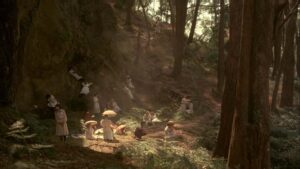
It’s 1975 and director Peter Weir, now mostly known for making juggernaut cult films The Truman Show and Dead Poets Society, is coming off the heels of his directorial debut film, The Cars That Ate Paris. Nestled in the newly emerging Australian film industry, the film will eventually lead to two distinctly different film movements within Australia: one being Australian New Wave, which will focus on more artistically-inclined films focusing on drama and mood-altering films with ties to Australia’s history and culture, and Ozploitation, which will focus on quickly-made gross-out comedies, exploitative horror, and violent action films that will act as the B films to many of the Australian New Wave films.
Weir was sitting nicely on the side of Ozploitation, thanks to The Cars That Ate Paris as well as work on the short film, Homesdale. He got his chance to make a film worth its weight in gold thanks to actor and producer Patricia Lovell. She wanted to make a film version of one of her favorite novels, Joan Lindsay’s Picnic at Hanging Rock, which was published just 3 years prior to its adaptation. With this moment, Peter Weir was able to expand upon his directing abilities and make an art film worthy of his own ambitions as a director. When the movie was released, it helped bring international attention to Australia’s newly-built film industry. Picnic at Hanging Rock had its moment, and it helped confer legitimacy on Australia’s cinema. For me, though, it’s one of the few movies from the Australian New Wave and Ozploitation scene that I know I should have seen years ago after digging into classic films like George Miller’s Mad Max and Joel Anderson’s Lake Mungo, two films that I have enjoyed from my childhood thanks to my dad’s love for Mel Gibson action films and my recent dive into horror films that are underrated due to initial critic ratings.
Like I said before though, Picnic at Hanging Rock is a film school movie that I think isn’t seen enough by film students. It takes a lot of time and effort to study and truly understand how an independent scene outside of studio interference can happen with the help of those around. Knowing this, I myself want to see how someone who pays very little for a novel’s film rights can hire a director who will adapt it the way the producer has in mind. The premise itself seems pretty straightforward though, with the disappearance of a teacher and their students happening during a picnic trip to the local scenic area known as Hanging Rock, but I believe it really comes into its own when it turns to the townsfolk, which I hope will help push the theories and notions that may hang hard on the local villagers’ minds, hearts, and souls while trying to figure out why such a tragedy could have happened in such a quiet and nice area of the countryside, near a mostly unassuming town that has little to no problems. It’s an unusual situation that would eventually be beaten into the ground by others later on, sometimes years after Picnic at Hanging Rock gained its status amongst the many other directors who would do bits and pieces of homages to many other parts of the film.
Even decades after its initial release, Picnic at Hanging Rock should be on any list of top tier Australian films.
Picnic at Hanging Rock screens at The Frida Cinema starting Sunday, July 31st.
Sunday, Jul 31 – 2:30pm
Monday, Aug 1 – 7:30pm
Tickets

